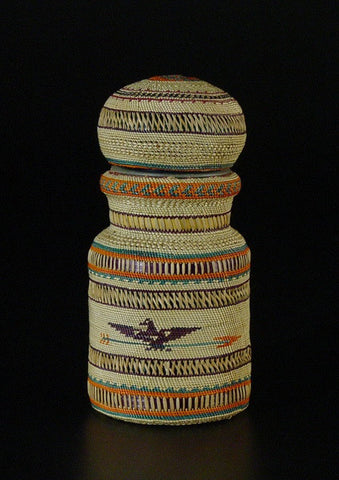Entwined Histories
At the beginning of the 20th century, the trade in Nuu chah nulth baskets was in full swing. Weavers could use the wrapped twining technique to create baskets with a texture so fine that they resembled fine linen. The form was not one used in a traditional, practical sense, but developed specifically for a non-native market. These "trinket" or "fancy" baskets were traded to European visitors and settlers in great numbers, and the artists often wove items that took the form of non-traditional objects, like teacups and shopping baskets. They were decorated with birds, seals, mythical thunderbirds, and whaling scenes, as well as the occasional dragon or steamboat.
By the 1960's and '70's, the number of artists had dwindled so that there were only a handful of master weavers still working, mostly ladies in their 60's and older. The art form was slowly bowing to the pressures of economics and a lack of interest by the younger generation. The work of the artist goes far beyond the mere construction of the basket, but requires that the materials be gathered by hand at specific times of the year, and prepared carefully before use. The grasses must be split into strands of an even gauge from end to end, to almost thread-like thinness for the finest weaves and the cedar bark, if used, must also be stripped and split. The time commitment involved is enormous, and rarely reflects the ultimate financial return.
The works represented in this collection reflect both the vision of a collector who recognized the difficulties that this art form was undergoing, and the mastery of weavers who had commited decades to learning and perfecting their art form. Some of the last great Nuu chah nulth weavers, such as Frances Williams, Mary Moses, and Martha Amos, are included here along with others whose names are unknown to us, but whose quality of work speaks for itself.
« First
« Previous
Page 1 of 1
Next »
Last »
« First
« Previous
Page 1 of 1
Next »
Last »

